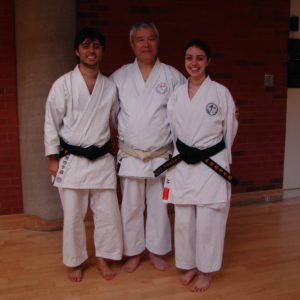
Recently, I watched an older video featuring a highly respected Wado instructor. The video began with a monologue in which the instructor discussed 空 “kara,” a Zen Buddhist concept of “understanding emptiness.” He explained how his Zen priest had assigned him the life task of “experiencing emptiness” and how he was working on that task through Karate.
The concept of “emptiness” originates from Zen and Buddhism.
As with many terms discussed on our website, I usually try to delve deeper into the actual Kanji used to represent the Japanese term. By examining the Kanji brush strokes and constituent parts, I aim to gain a better understanding of the concept and how it applies to my Wado practice.

空 – “kara” consists of two constituent parts (as per jisho.org). The bottom portion of this kanji, 工, means “craft, construction.” The top portion, 穴, has various meanings, but for this discussion, we will use the first three: “hole, aperture, slit.”
So, what do “craft and construction” have to do with “hole, aperture, and slit”? And how do these concepts help a Wado Yudansha practitioner not only understand but, more importantly, experience emptiness?
Let’s break this down into two parts: first, examining the concept by exploring the relationship between “creation and crafting” and “hole, aperture, and slit”; and second, discussing Wado practice and its connection to Kara.

- When I think about the connection between creation and crafting with hole, aperture, and slit, I recall Shiomitsu Sensei’s teachings during numerous clinics held in Toronto, Canada. He would explain that each technique should not be considered solely in its executed and “finished” state. One specific example is Sensei’s constant reminder to students that they must be prepared for attacks from ten directions (front, left, right, behind, up, down, diagonal front-left/front-right, back-left/back-right). So, as a practitioner, while I am “creating and crafting” my technique, I must consider each potential “hole, aperture, and slit.” In simpler terms, when practicing a Wado technique, I alternate between focusing on the actual technique and being aware of my surroundings, considering how this technique can be effective in various offensive and defensive scenarios.
Another excellent example of 空 from Sensei is his explanation that Wado is not merely two photographs taken at the beginning and end of a technique. He would emphasize that Wado does not occur only at those two points, but more importantly, in between (hole, slit).
2. The Western translation of the word “emptiness” is a very challenging concept; therefore, studying the actual kanji can help bring about a paradigm shift for the practitioner to consider “creating something that has no inherent nature and can always be broken down into its multiple parts.” Emptiness can also be seen as something that changes, just like how my practice of Junzuki has evolved since I first stepped onto the dojo floor nearly 30 years ago. To me, the concept of emptiness presents an opportunity, a “field of potential,” where I do not expect things to stay the same, as is the nature of the universe. In my practice, I continue to work on understanding and experiencing 空. So, how do I practice emptiness? Once again, thanks to Shiomitsu Sensei and his constant reminders of “just do it,” “no tension,” “smile,” and “practice, practice, practice,” I am at ease knowing that Wado practice does not need to be stale or rigid, but should consider the infinite combinations and permutations of situations and techniques. It is essential to remember and work on “proper” technical execution while also allowing the practice to happen. When Sensei made these comments during his courses, as a younger practitioner, I was pleasantly surprised at how enjoyable and memorable these statements made practice. Sensei was preparing our fertile minds and bodies to let go of excessive thinking and to feel our bodies as we moved from one stance to another or be flexible enough to adjust and let the practice happen.

In conclusion, I hope to continue deepening my practice by considering the emptiness nature of Wado and remembering what Shiomitsu Sensei always emphasized: always smile and practice hard!
-Ali M.
